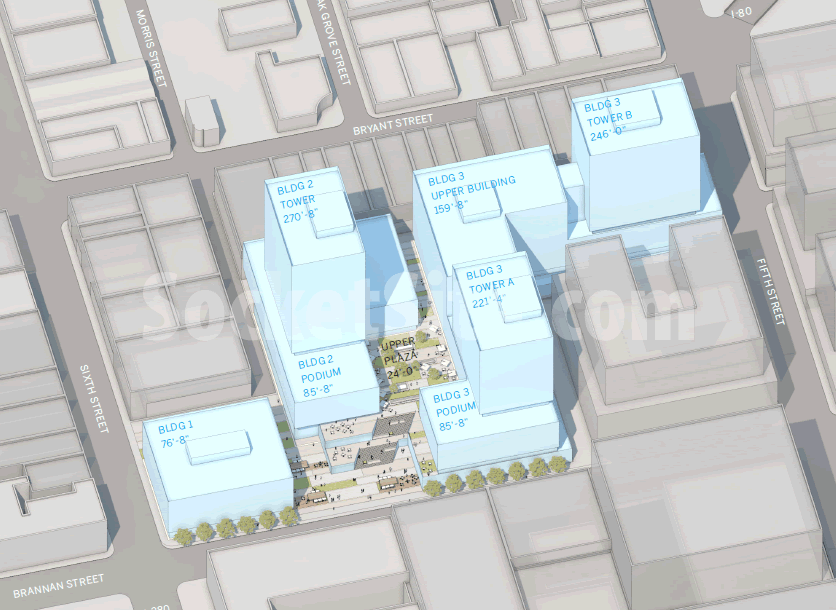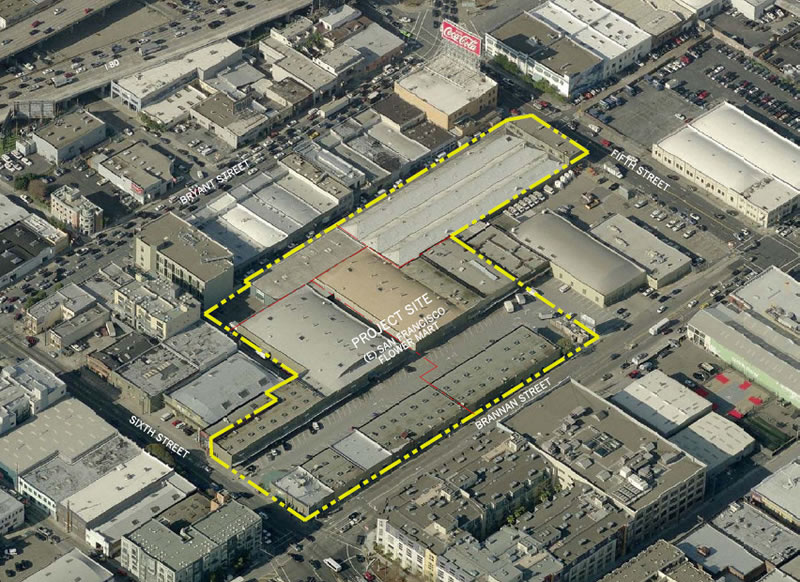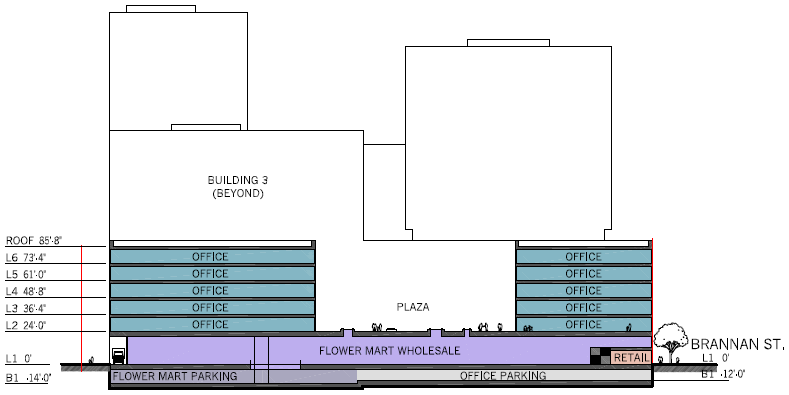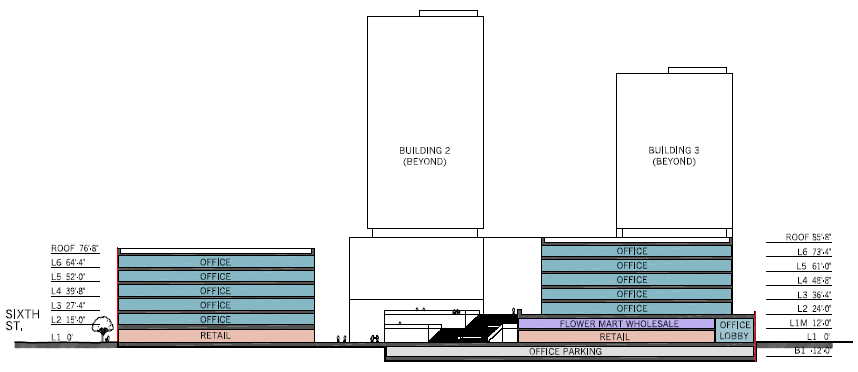Facing ongoing push-back from tenants of the San Francisco Flower Mart, Kilroy Realty has drafted an alternative design for their proposed re-development of the Flower Mart site which would ditch their plans for a high-tech underground market and keep the New Flower Mart above ground.
The alternate design also raises the proposed height of the tallest office tower to over 280-feet and creates a raised, multi-level plaza around which the buildings would wrap.
From the development team:
This proposal represents an alternate version of the Project, which was developed in response to feedback received from the tenants of the San Francisco Flower Mart (“Flower Mart”). The original version of the Project was developed in collaboration with San Francisco Flower Market, Inc. (“SFFM”, formerly the California Flower Market “CFM”), the former owner and operator of approximately two-thirds of the Property for nearly 100 years. Based on their expertise and knowledge of the flower business and its operations, the CFM Board of Directors, which included several tenants of the Flower Mart, concluded that a below-grade wholesale flower market and an adjacent below-grade parking area would be the best design for a new flower market (“New Flower Mart”), as it would create a smooth flow of goods between the warehouse and parking areas. After KR Flower Mart, LLC purchased the Property and SFFM took over operations of the aggregate Flower Mart, the developer presented the original below-grade plan for the Project.
Some existing Flower Mart tenants expressed concerns that a below-grade wholesale flower market may not be the best design for the New Flower Mart, due to lack of visibility and accessibility from street level. During a series of meetings with the tenants, the governing board of SFFM and representatives of the developer responded that the new, below-grade wholesale flower market would have prominent signage and access from street level. Some tenants also expressed concerns that a below-ground warehouse may be too dark and have poor air circulation, and that a parking area immediately adjacent to the warehouse could produce vehicle exhaust fumes that are potentially harmful to the flowers. SFFM Board members and representatives of the developer explained that the parking area would be sealed off from the warehouse and that skylights would bring natural light into the warehouse. Examples with photos of successful underground markets from around the world, including flower markets, were also provided.
Ultimately, some tenants still expressed a strong preference for an above-grade wholesale flower market. In response, KR Flower Mart, LLC offered to analyze the plausibility of an above-grade wholesale flower market within the Project. This proposal is the result of that analysis, and is similar to the version with a below-grade wholesale flower market submitted in February of 2015.
One difference is the parking and loading areas for the above-ground market. The parking area for the New Flower Mart remains below ground, creating the need for additional elevators, ramps and/or escalators to connect to the warehouse, while the loading area for the flower market is located above-grade, adjacent to the warehouse. The above-grade flower market also results in a multi-level plaza, with the portion above the warehouse elevated above street level.
This differs from the below-ground Flower Mart proposal, in which all plazas would be at grade. The skylights that existed in the original version have been moved to the elevated plaza to bring natural light down into the warehouse. As the flow of goods between the warehouse and parking areas is less efficient with an above-grade flower market, some tenants still prefer the original version of the Project. A majority of tenants, however, have expressed support for continuing to explore the above-grade version.
The alternate plans for the Flower Market site have been delivered to Planning and the potential for a ballot measure fight to block the development still looms.




It’s amazing that any developer is interested in working in San Francisco. Can you imagine the things we could be building if this city and its political processes actually welcomed investment (say, like for the first 130 years of San Francisco’s existence), instead of reviling it?
Seriously though we don’t have the infrastructure to even imagine what that would be like
No, I can’t imagine the things we could be building…tell us about it. The fact is, most of the stuff built in SF in the last 35 years isn’t that interesting or even useful. This project is nothing but more boring bland office space.
“We must preserve these shanties and lean-tos!!! How else will we preserve fur-trapper and gold-miner culture?? All these people building proper townhomes are DESTROYING THE CITY with their GREED”
I can imagine, I’m just back from the future (not ours): google dubai buildings, and all built in the last 20 years.
I googled it. It looks like a place I would never want to live or visit.
a nice place to visit. you and me both like the building in San Francisco .
If Dubai is your cup of tea…you should go back. Every little bit helps take the pressure off SF.
a nice place to visit, really nice interesting buildings. (BTW it takes 30 days to get a permit to build). I like San Francisco so I’m not selling my condo-sorry.
Dubai is an interesting experiment – but I bet less than 1% of the SF City population would move there given a chance. Way less than 1%.
In the previous 130 years things were built with a clear need and purpose. When they built a building, they owned it, they put their name on it and then occupied it. Hills Brothers, Pacific Telephone, Shell, Crown Zellerbach, Hancock Insurance, Bank of America to name just a few of the more prominent structures. Small buildings followed the same format.
These days things are largely developed by and for big spenders from out of town. As a result the development faces a lot of opposition and SF often ends up with uninspired buildings.
Right, ’cause Lucas’s plans to build Lucas’s museum with Lucas’s dollars were greeted with such open arms…
Not sure why you say that. Fact is, there are LOTS of developers interested in San Francisco. We may not be the easiest to develop, certainly not as difficult at Manhattan but there is desire and demand here.
And we are building things, lots of things. Seems like you are just looking at the glass “half empty”, instead of half full.
It’s a great opportunity, but it seems like this city lets anyone with an opinion in on the approval process. We have to consider the ‘rights’ of people who’s view might be blocked, you have to research if Grover Cleveland spat on the sidewalk (it’s historic now!), and you can’t forget the shadows! Anything casting a shadow could have a negative effect on the city.
They’re interested as long as the rents are ludicrous enough to justify the costs. Trouble with that is that the city can never grow out of being horribly unaffordable. Which, I suppose, suits some people just fine.
But rents HAVE to be of a certain value to make the business viable. That’s just common sense and good business practice. Making a profit is NOT illegal, last time I checked.
The City will always be “affordable” to many who can afford it, but not to all. There is no inherent right to being able to live here if you cannot afford it.
Well, of course. But the rents you need for a viable business here are much higher than the rents for a viable business elsewhere. In no small part as a direct result of a number of city policies.
The city may never be affordable to all, but it can make policy changes which increase or decrease the number of people who can afford it. Currently, there are a lot of policies which have the direct or indirect result of making the city unaffordable.
Seattle and Boston are growing (building) as fast or faster, despite having lower rents. Obviously lots of developers are building here, but my point is (and I’d think it pretty obvious, given some of the recent SocketSite articles) that we throw up so many hurdles to development that it perforce has to constrain the number and size of proposals. If we did not have the empowered NIMBY appeal process and rabidly anti-growth political culture, I have no doubt we’d be looking and far more (and more interesting) development proposals.
Why isn’t SF requiring Kilroy to PAY FOR ALL FLOWERS FOR ALL SUPPLIERS for the 1st 10 years.
kidding, of course! hahaha
Based on this any raised heights of buildings should be approved so they can pencil it out.
BTWs many of us with skin sensitive to the sun’s burn welcome a bit a of shade somewhere or at sometime in a public spaces/plaza. Most spaces don’t have adequate tree coverage and as a result my skin sizzles. Anyone ever thought of this?!
You must be of the pale persuasion, which means that your needs and desires can be safely neglected.
By all means, let’s racialize the discussion. Don’t be an asshat.
If you have sensitive skin, you should spend more time in the Financial District. 6 months of the year it’s cold and dark. Shadows do matter.
its clear from this that the majority of Flower Mart tenants want the space to remain above ground. The project killer will be the additional heights. Even if the large majority of tenants support the revised above ground plan, voters are not going to approve 20 plus story building in this area. IMO.
The supposed promise was that high-rise building could goup between 5th and the waterfront in SOMA. With greatly increased heights allowed.
But beyond that towers creeping west of 5th are a no no for most voters.
If the ballot measure succeeds in killing the project look forone to be launched against the proposed Chronicle building re-do. It too would go up to 30 stories and breach the more or less assumed line demarking the no-high-rise area from 5th all the way west into the outer Mission.
There are currently three 400ft. high-rises in various stages of planning approval for the intersection of Van Ness and Market and its immediate vicinity has more in the pipeline. Is that not west of 5th St. too? The point that I am trying to make is that perceived boundaries shift over time.
The Van Ness several block area up-zoning was supposedly a one-time special exception.
The understanding of many is that no more high-rises will be built outside the core SOMA area. Even the old financial district north of Market seems to have a defacto hi-rise freeze in place. Nothing new planned or proposed for a while and the one 30 story tower that was proposed a decade ago got shot down quickly.n
I think you are vastly overstating the “voters'” objection to modest heights in these areas and circumstances. Maybe a few strident “activists,” but not the rank-and-file. Besides, there is little likelihood of any ballot measure on this project as reformulated.
Trying to think of an example of a successful elevated plaza in any city. So far I’m drawing a blank. Honest question, can anyone think of one? Preferably in a modern context, so no Piazza del Campidoglios, please.
Union Square? OK, it’s not elevated much . . .
“Successful” is pretty subjective, but here in SF there’s Maritime Plaza just north of the Embarcadero Center. The High Line in NYC has some open-air gathering spaces. There’s also the Elevated Acre in NYC’s Financial District. In Hartford, there’s Constitution Plaza. Plus the inner part of Millennium Park in Chicago is elevated….it’s built over surface-level train tracks.
Sorry, but Maritime Plaza is *not* a successful elevated plaza. I can see it from my office; it’s barren all day, including lunchtime; and the few times I’ve passed through it it’s more like a windswept sculpture garden than a welcoming plaza.
The 2nd level of Embarcadero Center is arguably successful (though the landlord seems to have problems filling the retail spaces in One and in Three), but that’s only because four large office buildings have entrances on the 2nd level, not the ground floor. I have no doubt that if it weren’t for the directed office traffic, the 2nd level of Embarcadero Center would be a ghost town.
Agreed on the under-utilization of Maritime Plaza. Despite that, or maybe because of it, it’s a lovely spot to eat lunch (on days when the weather is cooperative), which makes it a “success” in my book.
If you’re basing this on volume of people, the High Line and Millennium Park definitely qualify.
the terrace above the MLK waterfall in Yeba Buena is kind of nice, though not nearly as popular as the lawn at the street level. And the two levels at the Music Concourse and museums in GG Park work ok. Many SF parks have some successful terracing with the topography. The ones where you can see between the levels and have an obvious path work much better than where there is an abrupt change or blind path. For example to get to the MLK terrace from Howard is either an elevator or a long staircase without any visibility to the terrace, whereas from the Mission side is much more inviting.
I don’t think successful is subjective, but maybe that wasn’t your point. It’s easy to see if a space is desirable, pleasant, well designed, etc.
I agree that the Embarcadero Center gets used, but does anyone willingly go there unless they’re working, seeing a movie or a comedy show? IMO, part of its failure is its detachment from the city. Same thing could happen at the Flower Mart, but at least the Flower Mart has some street level plaza area.
Union Square is possibly a good example, though it was much better before they elevated it for parking. Deja Vu.
Highline/Elevated Acre is a great example. I still can’t figure out why it works, but it does.
Constitution Plaza might be the most relevant example, but I wonder if it works for the same reasons as the Embarcadero.
This whole issue will come to the fore in spades with the opening of “City Park” (isn’t that the name of the rooftop greenery of the Transbay Transit Center?). I understand a single funicular is being touted as an inducement to get people up there from the street.
At one point does Constitutionality over private property rights get illegally trumped by over-reaching SF-specific policies? What a weird city. John Kilroy was just railing against San Diego where he has faced San Francisco style backlash over a development there, too. But San Diego is no San Francisco – as stupid as it is to go through the process of trying to build something here, there’s still a justification, so long as you have risk-averse and cheap cost of capital, and an investment horizon that won’t sunset before you’re able to even break ground (probably part of the reason lots of these deals trade hands so much before they even break ground…each new investor adding their touch and clearing some hurdle for the next).
Your error is in the belief that private property rights are constitutionally defined, which they are not – and that they trump the ability of government to provide for the common welfare, which is constitutionally defined. Rage however much you wish – development is a privilege conveyed by the community, not a “right”.
+1
This isn’t about property rights. The developer knew from the get-go that their proposal needed many variances from the current zoning to build their spec office building. So it should not come as any surprise that they have to make lots of compromises and concessions to get what they want. They chose this spot and knew (or should have known) that it would take a lot of work.
Move the flower mart. There is this whole section of the city 2 miles south — specifically, south of Cesar Chavez and east of 101. Plenty of space, lots of commercial food, restaurant supply companies, and other light industrial / commercial uses. Perfect location for the flower mart.
totally agree. this land is too valuable for a flower mart. and no longer a good place for deliveries, etc.
As someone above said this is just another bland office complex which is de rigeur for SF these past decades. Nothing memorable though the developer is to be commened for retaining the Flower Mart.
Indeed rents are cheaper in Seattle as the poster noted and there is more building going on there than in SF.
And far more engaging projects. Office integrated with green belts, streams, housing units and retail all done in a far more intimate and people friendly style than anything being done in SF.
Seattle’s focus on “intimate” development stands in contrast to SF’s focu on institutional development. Mission Bay the perfect example of that. What could have been there – the once proposed canals, non-grid street pattern and such – that is the type of thing being done in Seattle. That is why Seattle is emerging as one of the great cities of the West Coast and beyond. Something SF probably can never achieve – this development says it all.
Are you from the Seattle Tourist Board?
“There is more building going on there”
Last I checked, their building boom is on a very similar scale as our own.
Rather than trying to hide the Flower Market, it should be featured as an attractive element of the design.
Look how a market was integrated into a building in Rotterdam.
While you may not like that rather avant-garde design, I could imagine a glass-enclosed area that’s an architectural nod to the SF Arboretum. There could be truck access below ground, but floral displays on the main level. Put in a cafe and restaurant – and you’d have a nice complex of buildings.